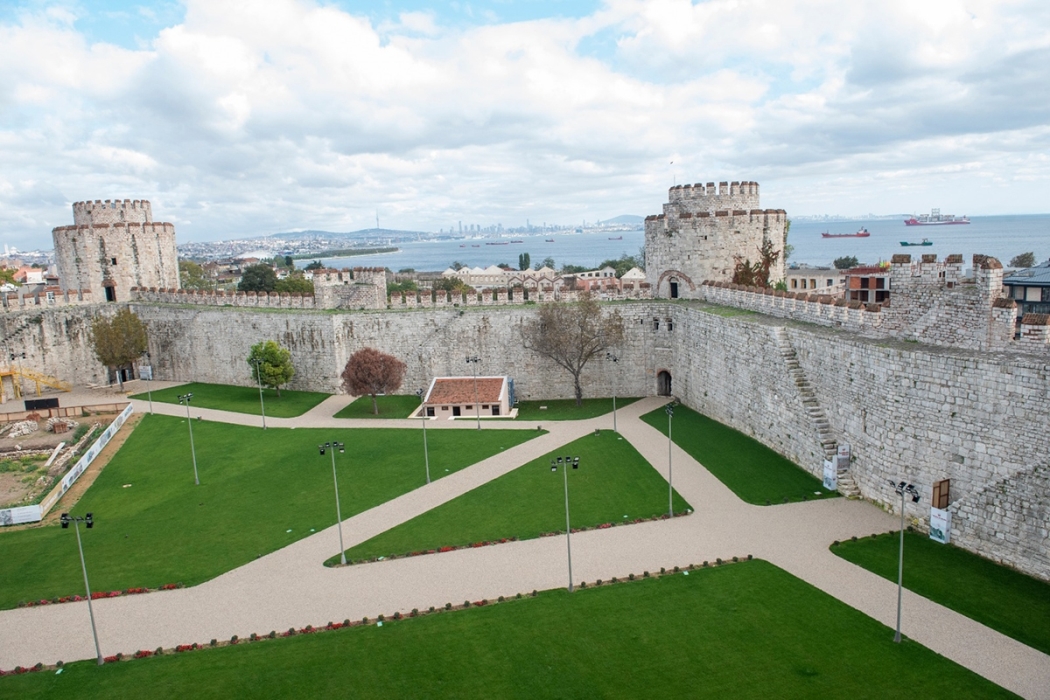News
Yedikule Fortress
Yedikule Fortress (Yedikule Hisarı) is one of the most magnificent monuments of Byzantine and Ottoman cultural heritage. Two different periods have been living side by side for centuries without overlapping each other.
16 September 2021
Yedikule Fortress was built behind the Golden Gate, one of the important gates of Istanbul's land walls, by the order of Mehmed the Conqueror after his conquest (in 1457-1458).
Yedikule Fortress was designed in the form of a star with the addition of three towers and walls connecting the towers towards the city, behind the 5th-century Golden Gate and four towers of the land walls built by Theodosius II. These seven towers, built in the form of an inner castle, gave the name to the fortress and then to the surrounding area.
Yedikule Fortress, which was a small neighborhood with its houses, mosque and water well until the end of the 19th century, was used as a prison where local and foreign statesmen and ambassadors were captured for a long time during the Ottoman Period. In addition, sources also mention that it was used in different functions for a short time at different turns. It is known that for some time the state treasury was kept in the fortress, Miri lions were kept here, and the fortress had a firecracker and Inas school for Girls.
Some parts of Hisar, which were associated with the General Directorate of Museums in 1895 and began to be used as a museum; were restored by architect Cahid Tamer between 1958 and 1970.
After it was handed over to the Fatih Municipality in 2019, a dynamic restoration process was started in Yedikule Fortress. While the project and the restoration process continue as a museum that will host international cultural and artistic events, it has opened its doors to visitors.
GOLDEN GATES
There are also many small gates and passages on the walls. The Golden Gate, which was in Yedikule during the Byzantine Period, was considered the most prestigious gate of the city. The Via Egnatia (Oak Road), which stretched from the Balkans to Istanbul, passed through the Golden Gate and reached Hagia Sophia Square. Emperors solemnly left the city and used this gate on their way back. The Golden Gate got its name from the gilding used in the bronze door leaves and ornaments.
There is no clear consensus among experts as to the date of construction and order of the Golden Gate, which is a triumphal arch with three arches and two towers covered in marble. According to one claim, the Golden Gate was built as a triumphal arch around 390, during the reign of Theodosius I.
According to another claim, the Golden Gate was built as a single unit between 413 and 439 with two marble towers (South Pylon, North Pylon) next to them during Theodosius II, and then the Small Golden Gate (Propyl) was added to the outside of the structure. The towers on the right and left sides of the Golden Gate, built of marble brought from the island of the Sea of Marmara, were built by Emperor II. It was connected to the city walls built by Anthemius, the governor of Theodosius. The sources tell us that on the Golden Gate there is a bronze statue of Nike, the goddess of victory, and an elephant-drawn chariot as well as a Latin inscription written in gilded bronze letters on the arches. According to the sources, this inscription reads: “Theodosius adorned these places after the downfall of the tyrant. He brought a golden age who built the gate from gold”. On the stones, you can still see the cavities in which these statues and letters were placed, which were lost due to the earthquake and the Latin domination before the conquest and have not survived.
The doorways of the magnificent Golden Gate; were knit and made smaller at different periods in direct proportion to the weakening of the Byzantine Empire. After the conquest, its use was entirely discontinued.
LITTLE GOLDEN GATE
The Little Golden Gate was built between the city wall and the moat in front of the Golden Gate, one of the city's most important entrances to the sea, for protection purposes. On the exterior of the Little Golden Gate, there were twelve relief plates on which mythological stories were engraved in marble frames. These plates were removed by Sir Thomas Roe, who was in Istanbul as British ambassador between 1621 and 1628, and were prevented from doing so by the opposition of others. Unfortunately, the whereabouts of these plates, which have not reached us, are unknown.
In 1838 the coat of arms of the Ottoman Empire was engraved on the pediment of the outer arch of the Little Golden Gate, and the tughra of Mahmud II was placed there. However, just like the plates, they did not reach the present day.
RESTORATION
The land walls of the Byzantine Period and the Golden Gate, one of the most important gates, as well as the Yedikule Fortress consisting of towers and walls built during the Ottoman Period, continue to be restored in stages.
As part of the 1st stage works, the structural reinforcement work on the statically fragile wall between the North Pylon Tower and Ahmet III Tower and the Fatih Masjid Minaret has been completed. In addition, as part of the improvement of the middle courtyard; Cleaning, jointing, and repair work was carried out on certain wall surfaces. In addition, excavations were carried out on Fatih Masjid in Yedikule Fortress under the supervision of the Istanbul Turkish and Islamic Arts Museum Directorate, and the original foundations of the mosque were reached.
During the excavations, the oldest sidewalk of Istanbul that could be detected was reached in the direction of the Golden Gate overlooking the inner courtyard. The original 1,500-year-old Byzantine sidewalk has been replaced by the original sidewalk of the Fatih period (1453) in front of the Fatih Mosque.







